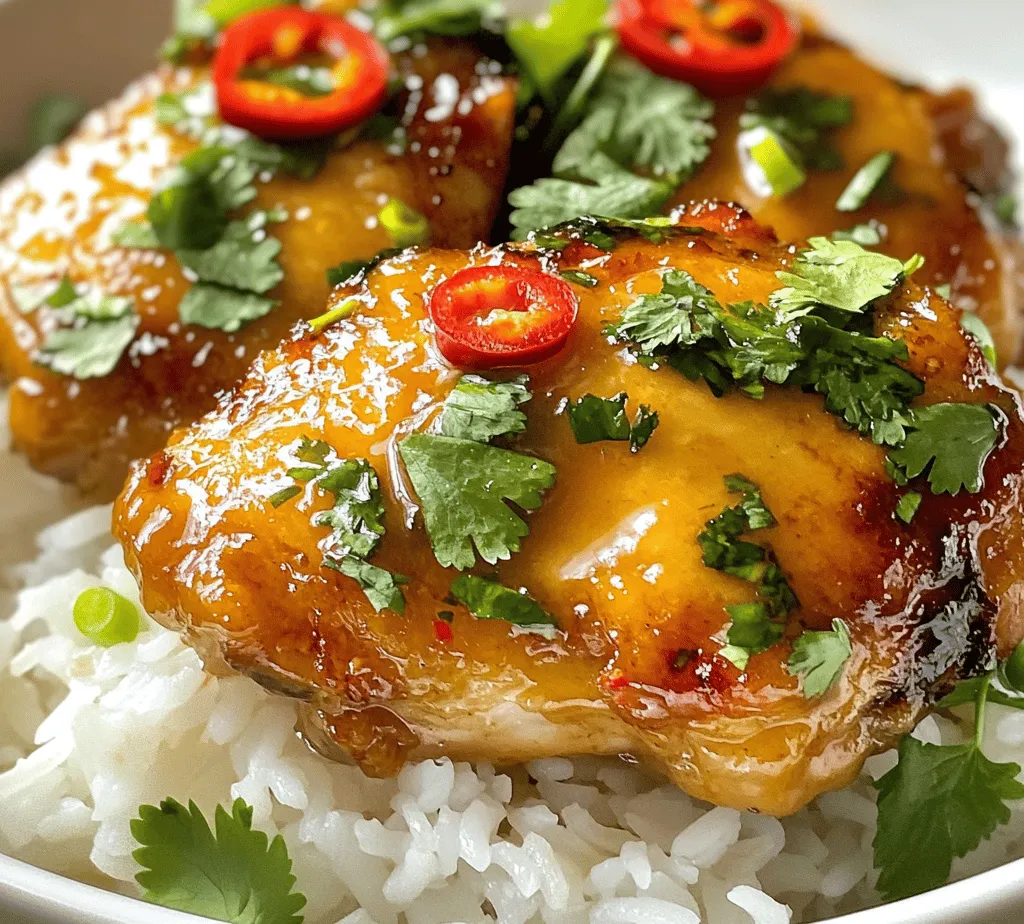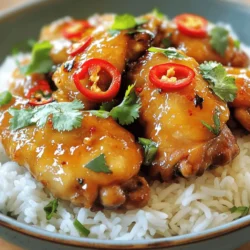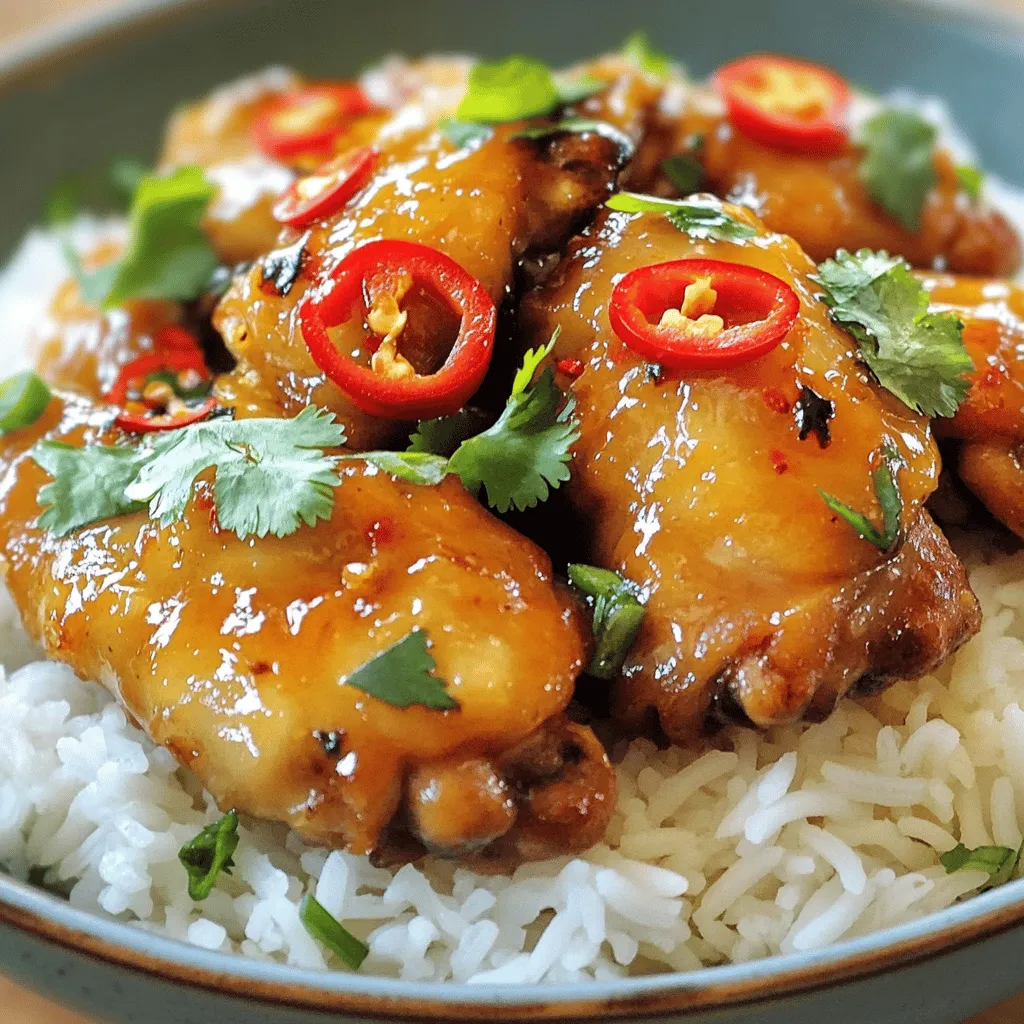Introduction
Vietnamese cuisine is known for its vibrant flavors, fresh ingredients, and a harmonious balance of sweet, salty, and spicy elements. It’s a culinary experience that invites diners to savor the complexity of its dishes, often rooted in traditional cooking methods that highlight the use of herbs, spices, and sauces. One standout recipe in this rich tapestry of flavors is Vietnamese Caramel Ginger Chicken. This delightful dish encapsulates the essence of Vietnamese cooking, combining the sweetness of caramel with the fragrant warmth of ginger, resulting in a meal that is both comforting and delicious.
What makes Vietnamese Caramel Ginger Chicken particularly appealing is its quick preparation and the versatility it offers in various meal settings. Whether it’s a weeknight dinner or a special gathering, this dish can easily adapt to different occasions. The combination of tender chicken thighs, aromatic spices, and a luscious caramel sauce creates a flavor profile that is sure to impress anyone at the table.
In this article, we will delve into the intricacies of preparing this delightful dish, starting from understanding the ingredients to the marination process and creating the perfect caramel sauce. Let’s embark on this culinary adventure and discover how to whip up a plate of Vietnamese Caramel Ginger Chicken that is bursting with flavor.
Understanding the Ingredients
To create a truly authentic Vietnamese Caramel Ginger Chicken, it’s essential to understand the role each ingredient plays in the dish. Let’s break down the key components that make this recipe so special:
Chicken Thighs
For this recipe, chicken thighs are the preferred cut of meat. Unlike chicken breasts, which can dry out during cooking, thighs remain tender and juicy even when cooked at higher temperatures. Their slightly higher fat content adds richness to the dish, allowing them to soak up the flavors of the marinade and sauce beautifully. This ensures that every bite is packed with flavor and moisture, making it an ideal choice for our caramel ginger chicken.
Fish Sauce and Soy Sauce
Both fish sauce and soy sauce are critical elements in achieving the umami flavor profile that Vietnamese cuisine is renowned for. Fish sauce, made from fermented fish, adds a depth of savory flavor that is distinctly Vietnamese. It enhances the overall taste of the dish, providing a salty element that balances the sweetness of the caramel. Soy sauce, on the other hand, contributes a rich and complex flavor while also adding a bit of color to the dish. Together, these sauces create a savory base that elevates the chicken to new heights.
Brown Sugar
Brown sugar plays a pivotal role in this recipe by not only providing sweetness but also contributing to the caramelization process. The molasses content in brown sugar gives the caramel sauce its deep, rich flavor and color. It is essential to use the right amount of sugar to balance the savory elements of fish sauce and soy sauce while enhancing the overall taste of the dish. The caramel formed from brown sugar serves as the glue that binds the flavors together, creating a luscious sauce that clings to the chicken.
Fresh Ginger and Garlic
No Vietnamese dish is complete without the aromatic contributions of fresh ginger and garlic. Ginger adds a warm, spicy note that complements the sweetness of the caramel, while garlic infuses the dish with a robust flavor. Together, they create a fragrant aroma that fills the kitchen and entices everyone to the dining table. Using fresh ginger and minced garlic ensures that the flavors are vibrant and pronounced, essential for a dish that relies on the complexity of its ingredients.
Chilies
Adding chilies to the recipe allows for customization according to your heat preference. Whether you like it mild or prefer a spicy kick, adjusting the number and type of chilies can elevate the dish to your liking. Fresh red or green chilies can be sliced and added, or you can opt for dried chilies to infuse the sauce with heat. Including chilies not only adds flavor but also a lovely visual contrast to the dish.
Coconut Water vs. Water
When it comes to adding liquid to the dish, you have the option of using coconut water or plain water. Coconut water brings a subtle sweetness and a hint of tropical flavor, enhancing the overall taste of the chicken. Additionally, it adds nutritional benefits, such as electrolytes and minerals, making it a healthier option. If coconut water is unavailable, regular water can be used, but it may not impart the same depth of flavor.
Nutritional Benefits of the Ingredients
The ingredients used in Vietnamese Caramel Ginger Chicken not only contribute to its delicious taste but also offer a range of nutritional benefits. Chicken thighs provide high-quality protein, essential for muscle health and repair. Fresh ginger and garlic are known for their anti-inflammatory properties and immune-boosting capabilities. The use of fish sauce and soy sauce, while adding flavor, should be moderated due to their sodium content. However, when balanced with the natural sweetness of brown sugar and the hydration from coconut water, this dish can be part of a healthy meal plan.
The Marination Process
One of the most critical steps in preparing Vietnamese Caramel Ginger Chicken is the marination process. Marinating the chicken thighs allows the flavors to penetrate the meat, resulting in a dish that is not only flavorful but also tender and juicy. Here’s how to marinate the chicken effectively:
Importance of Marinating Chicken
Marinating is essential for flavor infusion, especially in a dish like this, where the balance of sweet, savory, and spicy is crucial. The marinade allows the ingredients—fish sauce, soy sauce, brown sugar, ginger, garlic, and chilies—to meld together, creating a complex flavor profile that will enhance the chicken as it cooks. Additionally, marinating helps to tenderize the meat, making it more enjoyable to eat.
Step-by-Step Explanation of How to Marinate Chicken Thighs
1. Prepare the Marinade: In a mixing bowl, combine the fish sauce, soy sauce, brown sugar, minced ginger, minced garlic, and sliced chilies. Stir until the brown sugar is dissolved and the ingredients are well blended.
2. Add the Chicken: Place the chicken thighs in the bowl with the marinade. Ensure that each piece of chicken is thoroughly coated with the marinade.
3. Cover and Refrigerate: Cover the bowl with plastic wrap or transfer the chicken and marinade into a resealable plastic bag. Refrigerate for at least 30 minutes, but for the best results, let it marinate for 2 to 4 hours or overnight. This allows the flavors to deepen and the chicken to absorb the marinade.
Recommended Marination Time and Tips for Best Results
For optimal flavor, aim to marinate the chicken for at least 2 hours. However, if time allows, marinating overnight is even better as it enhances the flavor even further. Be cautious not to marinate for too long, as the fish sauce can break down the proteins in the chicken, leading to a mushy texture.
When marinating, consider the following tips:
– Use a non-reactive bowl: Glass or plastic bowls are ideal for marinating, as they won’t react with the acids in the marinade.
– Massage the marinade into the chicken: For maximum flavor infusion, take a moment to massage the marinade into the chicken thighs before refrigerating.
– Keep it covered: Always cover your marinating chicken to prevent contamination and to keep the flavors concentrated.
Creating the Caramel Sauce
Once the chicken has marinated to perfection, the next step is to make the caramel sauce. The caramel is what truly elevates this dish, providing a sweet and savory base that coats the chicken beautifully. Here’s how to create the perfect caramel sauce:
Detailed Instructions on Making the Perfect Caramel Sauce
1. Heat the Sugar: In a large, heavy-bottomed skillet or wok, add the brown sugar over medium heat. Allow it to melt slowly without stirring—this will help achieve a smooth, even caramel.
2. Watch for Color Changes: As the sugar begins to melt, it will start to bubble. Keep a close eye on it, as the sugar can go from perfectly caramelized to burnt very quickly. Look for a deep amber color, which indicates that the caramel is ready.
3. Add Water: Once you achieve the desired color, carefully add a small amount of water to the pan. Be cautious, as the mixture will bubble vigorously. Stir gently to combine, allowing the sugar to dissolve completely.
4. Combine with Marinade: After the caramel has reached the right consistency, add the marinated chicken along with the marinade into the skillet. Stir well to coat the chicken with the caramel sauce.
The Significance of the Right Temperature and Timing
The temperature and timing are critical in successfully making caramel sauce. If the heat is too high, the sugar can burn, leading to an unpleasant bitterness. Conversely, cooking at too low a temperature can result in a syrupy mixture that doesn’t caramelize properly. Striking the right balance is essential for achieving the rich flavor and depth that defines this dish.
Tips on Avoiding Burnt Sugar and Achieving the Ideal Consistency
To avoid burnt sugar, follow these tips:
– Use a heavy-bottomed pan: This helps distribute heat evenly, reducing the risk of hot spots that can cause burning.
– Do not stir: Allow the sugar to melt undisturbed until it reaches the desired color. Stirring can cause crystallization, leading to a grainy texture.
– Adjust the heat: If you notice the sugar starting to darken too quickly, lower the heat to prevent burning.
Achieving the ideal consistency for your caramel sauce is equally important. It should be thick enough to coat the chicken but not so thick that it hardens upon cooling. If you find the sauce too thick, you can add a little more water during the cooking process to reach the desired consistency.
By carefully selecting your ingredients, marinating the chicken properly, and mastering the caramel sauce, you’re well on your way to creating a mouthwatering dish of Vietnamese Caramel Ginger Chicken. In the next section, we will explore how to bring this dish to completion, so stay tuned for the continuation of this culinary journey.


